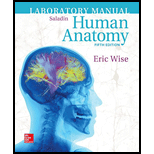
Laboratory Manual for Human Anatomy
5th Edition
ISBN: 9781259683831
Author: Eric Wise, Kenneth S. Saladin Dr.
Publisher: McGraw-Hill Education
expand_more
expand_more
format_list_bulleted
Concept explainers
Question
Chapter 4.2, Problem 9BYGO
Summary Introduction
To distinguish:
Between topographic and placental nutrition.
Introduction:
During gestation, the conceptus needs nourishment. There are 3 different ways of conceptus nourishment. These areuterine milk nourishment, topographical and placental nourishment.
Expert Solution & Answer
Want to see the full answer?
Check out a sample textbook solution
Students have asked these similar questions
What is the structure and function of Eukaryotic cells, including their organelles? How are Eukaryotic cells different than Prokaryotic cells, in terms of evolution which form of the cell might have came first? How do Eukaryotic cells become malignant (cancerous)?
What are the roles of DNA and proteins inside of the cell? What are the building blocks or molecular components of the DNA and proteins? How are proteins produced within the cell? What connection is there between DNA, proteins, and the cell cycle? What is the relationship between DNA, proteins, and Cancer?
Why cells go through various types of cell division and how eukaryotic cells control cell growth through the cell cycle control system?
Chapter 4 Solutions
Laboratory Manual for Human Anatomy
Ch. 4.1 - Prob. 1BYGOCh. 4.1 - Prob. 2BYGOCh. 4.1 - Prob. 3BYGOCh. 4.1 - Describe two ways a fertilized egg prevents the...Ch. 4.2 - List the four primary tissue types of the adult...Ch. 4.2 - Oligohydramnios17 is an abnormally low volume of...Ch. 4.2 - Prob. 5BYGOCh. 4.2 - Prob. 6BYGOCh. 4.2 - Prob. 7BYGOCh. 4.2 - Prob. 8BYGO
Ch. 4.2 - Prob. 9BYGOCh. 4.2 - Prob. 10BYGOCh. 4.2 - Define and describe the neural tube, primitive...Ch. 4.3 - Prob. 1AWYKCh. 4.3 - Prob. 12BYGOCh. 4.3 - Prob. 13BYGOCh. 4.3 - Prob. 14BYGOCh. 4.3 - Answer the following questions to test your...Ch. 4 - Prob. 4.1.1AYLOCh. 4 - Prob. 4.1.2AYLOCh. 4 - Prob. 4.1.3AYLOCh. 4 - Prob. 4.1.4AYLOCh. 4 - Prob. 4.1.5AYLOCh. 4 - Prob. 4.1.6AYLOCh. 4 - Prob. 4.1.7AYLOCh. 4 - Prob. 4.1.8AYLOCh. 4 - The duration of pregnancy and how the date of...Ch. 4 - Prob. 4.2.2AYLOCh. 4 - Prob. 4.2.3AYLOCh. 4 - Prob. 4.2.4AYLOCh. 4 - Prob. 4.2.5AYLOCh. 4 - Prob. 4.2.6AYLOCh. 4 - Prob. 4.2.7AYLOCh. 4 - Prob. 4.2.8AYLOCh. 4 - Prob. 4.2.9AYLOCh. 4 - The major changes that occur during the embryonic...Ch. 4 - Prob. 4.2.11AYLOCh. 4 - How the coelom forms, how it divides into the...Ch. 4 - The meaning of organogenesis, and some tissues and...Ch. 4 - Prob. 4.2.14AYLOCh. 4 - Prob. 4.2.15AYLOCh. 4 - Prob. 4.2.16AYLOCh. 4 - Prob. 4.2.17AYLOCh. 4 - Prob. 4.2.18AYLOCh. 4 - Prob. 4.2.19AYLOCh. 4 - The three modes in which the conceptus is...Ch. 4 - The development and mature structure of the...Ch. 4 - The relationship of the placenta to the umbilical...Ch. 4 - Prob. 4.2.23AYLOCh. 4 - The time at which the individual is considered to...Ch. 4 - Prob. 4.2.25AYLOCh. 4 - Prob. 4.3.1AYLOCh. 4 - Prob. 4.3.2AYLOCh. 4 - Prob. 4.3.3AYLOCh. 4 - Clinical Perspectives (p. 100) The meaning of...Ch. 4 - Prob. 4.3.5AYLOCh. 4 - Prob. 4.3.6AYLOCh. 4 - Prob. 4.3.7AYLOCh. 4 - When a conceptus arrives in the uterus, it is at...Ch. 4 - The entry of a sperm nucleus into an egg must be...Ch. 4 - Prob. 3TYRCh. 4 - Prob. 4TYRCh. 4 - Which of these results from aneuploidy? Turner...Ch. 4 - Prob. 6TYRCh. 4 - Prob. 7TYRCh. 4 - Prob. 8TYRCh. 4 - Prob. 9TYRCh. 4 - For the first 8 weeks of gestation, a conceptus is...Ch. 4 - Viruses and chemicals that cause congenital...Ch. 4 - Prob. 12TYRCh. 4 - Prob. 13TYRCh. 4 - Prob. 14TYRCh. 4 - Prob. 15TYRCh. 4 - The enzymes with which a sperm penetrates an egg...Ch. 4 - Prob. 17TYRCh. 4 - Prob. 18TYRCh. 4 - Prob. 19TYRCh. 4 - Prob. 20TYRCh. 4 - Prob. 1BYMVCh. 4 - Prob. 2BYMVCh. 4 - Prob. 3BYMVCh. 4 - Prob. 4BYMVCh. 4 - Prob. 5BYMVCh. 4 - Prob. 6BYMVCh. 4 - Prob. 7BYMVCh. 4 - Prob. 8BYMVCh. 4 - Prob. 9BYMVCh. 4 - Prob. 10BYMVCh. 4 - Prob. 1TOFCh. 4 - Prob. 2TOFCh. 4 - Prob. 3TOFCh. 4 - Prob. 4TOFCh. 4 - Prob. 5TOFCh. 4 - Prob. 6TOFCh. 4 - Prob. 7TOFCh. 4 - Prob. 8TOFCh. 4 - Prob. 9TOFCh. 4 - Prob. 10TOFCh. 4 - Only one sperm is needed to fertilize an egg, yet...Ch. 4 - Prob. 2TYCCh. 4 - Prob. 3TYCCh. 4 - Prob. 4TYCCh. 4 - Prob. 5TYC
Knowledge Booster
Learn more about
Need a deep-dive on the concept behind this application? Look no further. Learn more about this topic, biology and related others by exploring similar questions and additional content below.Similar questions
- In one paragraph show how atoms and they're structure are related to the structure of dna and proteins. Talk about what atoms are. what they're made of, why chemical bonding is important to DNA?arrow_forwardWhat are the structure and properties of atoms and chemical bonds (especially how they relate to DNA and proteins).arrow_forwardThe Sentinel Cell: Nature’s Answer to Cancer?arrow_forward
- Molecular Biology Question You are working to characterize a novel protein in mice. Analysis shows that high levels of the primary transcript that codes for this protein are found in tissue from the brain, muscle, liver, and pancreas. However, an antibody that recognizes the C-terminal portion of the protein indicates that the protein is present in brain, muscle, and liver, but not in the pancreas. What is the most likely explanation for this result?arrow_forwardMolecular Biology Explain/discuss how “slow stop” and “quick/fast stop” mutants wereused to identify different protein involved in DNA replication in E. coli.arrow_forwardMolecular Biology Question A gene that codes for a protein was removed from a eukaryotic cell and inserted into a prokaryotic cell. Although the gene was successfully transcribed and translated, it produced a different protein than it produced in the eukaryotic cell. What is the most likely explanation?arrow_forward
- Molecular Biology LIST three characteristics of origins of replicationarrow_forwardMolecular Biology Question Please help. Thank you For E coli DNA polymerase III, give the structure and function of the b-clamp sub-complex. Describe how the structure of this sub-complex is important for it’s function.arrow_forwardMolecular Biology LIST three characteristics of DNA Polymerasesarrow_forward
arrow_back_ios
SEE MORE QUESTIONS
arrow_forward_ios
Recommended textbooks for you
 Nutrition Through The Life CycleHealth & NutritionISBN:9781337919333Author:Brown, Judith E.Publisher:Cengage Learning,
Nutrition Through The Life CycleHealth & NutritionISBN:9781337919333Author:Brown, Judith E.Publisher:Cengage Learning, Human Physiology: From Cells to Systems (MindTap ...BiologyISBN:9781285866932Author:Lauralee SherwoodPublisher:Cengage Learning
Human Physiology: From Cells to Systems (MindTap ...BiologyISBN:9781285866932Author:Lauralee SherwoodPublisher:Cengage Learning Biology (MindTap Course List)BiologyISBN:9781337392938Author:Eldra Solomon, Charles Martin, Diana W. Martin, Linda R. BergPublisher:Cengage Learning
Biology (MindTap Course List)BiologyISBN:9781337392938Author:Eldra Solomon, Charles Martin, Diana W. Martin, Linda R. BergPublisher:Cengage Learning Human Biology (MindTap Course List)BiologyISBN:9781305112100Author:Cecie Starr, Beverly McMillanPublisher:Cengage Learning
Human Biology (MindTap Course List)BiologyISBN:9781305112100Author:Cecie Starr, Beverly McMillanPublisher:Cengage Learning

Nutrition Through The Life Cycle
Health & Nutrition
ISBN:9781337919333
Author:Brown, Judith E.
Publisher:Cengage Learning,

Human Physiology: From Cells to Systems (MindTap ...
Biology
ISBN:9781285866932
Author:Lauralee Sherwood
Publisher:Cengage Learning

Biology (MindTap Course List)
Biology
ISBN:9781337392938
Author:Eldra Solomon, Charles Martin, Diana W. Martin, Linda R. Berg
Publisher:Cengage Learning

Human Biology (MindTap Course List)
Biology
ISBN:9781305112100
Author:Cecie Starr, Beverly McMillan
Publisher:Cengage Learning


Nutrition and Diet - GCSE Biology (9-1); Author: Mr Exham Biology;https://www.youtube.com/watch?v=SFE1DfAlipo;License: Standard Youtube License